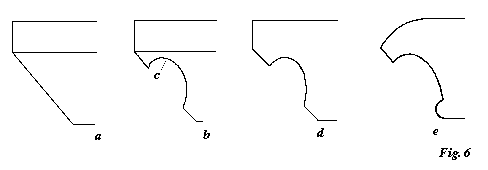96 THE STONES OF VENICE CONSTRUCTION
as the conditions are limited, the forms become determined; and our steps will be more clear and certain the farther we advance. The sources of a river are usually half lost among moss and pebbles, and its first movements doubtful in direction; but, as the current gathers force, its banks are determined, and its branches are numbered.1
§ 9. So far of the true cornice; we have still to determine the form of the dripstone.
We go back to our primal type or root of cornice, a of Fig. 5. We take this at a in Fig. 6, and we are to consider
 |
it entirely as a protection against rain. Now the only way in which the rain can be kept from running back on the slope of X is by a bold hollowing out of it upwards, b. But clearly, by thus doing, we shall so weaken the projecting part of it that the least shock would break it at the neck, c; we must therefore cut the whole out of one stone which will give us the form d. That the water may not lodge on the upper ledge of this, we had better round it off: and it will better protect the joint at the bottom of the slope if we let the stone project over it in a roll, cutting the recess deeper above. These two changes are made in e; e is the type of dripstones; the projecting part being, however, more or less rounded into an
1 [The MS. has here an additional sentence:-
“If the reader chooses for a moment to anticipate his more regular progress, and will glance at the forms of cornice developed in Plate-[15], he will, I doubt not, be surprised to find by what slight decorative additions all of them are produced from the two simple profiles already [given] in fig. 5 above, or from the third type resulting from the combination of these two.”]
[Version 0.04: March 2008]